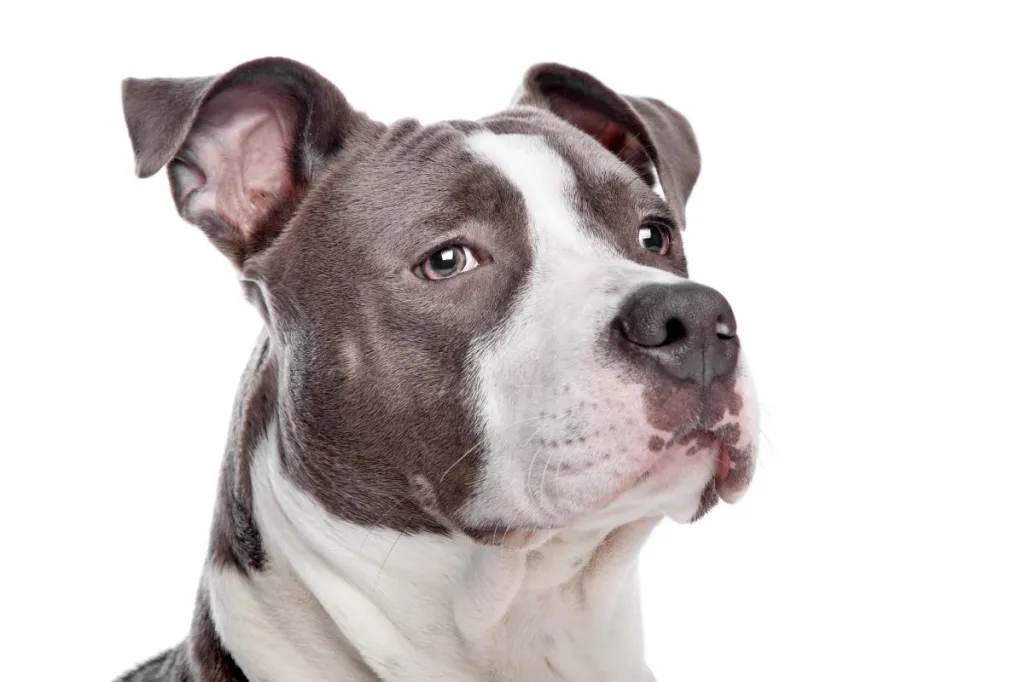The American Pit Bull Terrier is a companion and family dog breed. Originally bred to “bait” bulls, the breed evolved into all-around farm dogs, and later moved into the house to become “nanny dogs” because they were so gentle around children.
The term “pit bull” is not an official breed, but rather an umbrella term that refers to a group of breeds that share similar physical characteristics. There different types of “pit bulls, with the four most common being the American Pit Bull Terrier, the American Staffordshire Terrier, the Staffordshire Bull Terrier, and the American Bully.
Pit bulls have a reputation for being aggressive. However, this is largely due to their history of being used in fighting rings. In reality, Pit Bulls are no more aggressive than any other breed of dog. In fact, they have been ranked as the 4th most gentle breed by the American Temperament Test Society. Pit bulls are often the target of breed discrimination. They are banned in some cities and towns, and they are often denied insurance coverage. This is unfortunate, as Pit Bulls are loving and loyal dogs that make great family pets.
Quick Facts
- Origin: United States
- Size: Pit Bulls are a medium-sized breed. Males stand 18-19 inches tall at the shoulder and weigh 35-60 pounds; females stand 17-18 inches tall and weigh 30-50 pounds
- Lifespan: 12-14 years
- Coat: Short, smooth coat that comes in a variety of colors, including black, brown, white, brindle, and red
- Temperament: Affectionate, loyal, playful, and intelligent
- Exercise needs: Moderate; needs at least 30 minutes of exercise per day
- Training: Easy to train but can be stubborn
- Grooming: Low-maintenance; brush once a week
- Health: Prone to hip dysplasia, elbow dysplasia, and allergies
- The Pit Bull is the only breed to have graced the cover of Life Magazine three times. The first time was in 1942, with a photo of a Pit Bull named Petey from the Our Gang comedy shorts. The second time was in 1965, with a photo of a Pit Bull named Stubby, who served as a mascot for the 102nd Infantry in World War I. The third time was in 1971, with a photo of a Pit Bull named Sweet Pea, who was a therapy dog for children with disabilities.
- In the film “Once Upon a Time in Hollywood,” an American Pit Bull terrier named Sayuri played Brad Pitt’s dog “Brandy.”
- In the television series “Veronica Mars,” the titular character had a Pit Bull named “Backup.”
- Rapper and singer Armando Christian Pérez stated in his autobiography, “Pitbull: Mr. Worldwide,” that he chose the stage name of “Pitbull,” because ““(Pitbulls) bite to lock. He added, “They’re basically everything that I am. It’s been a constant fight.”
Related: Pit Bull Puppies: Cute Pictures & Facts
American Pit Bull Pictures
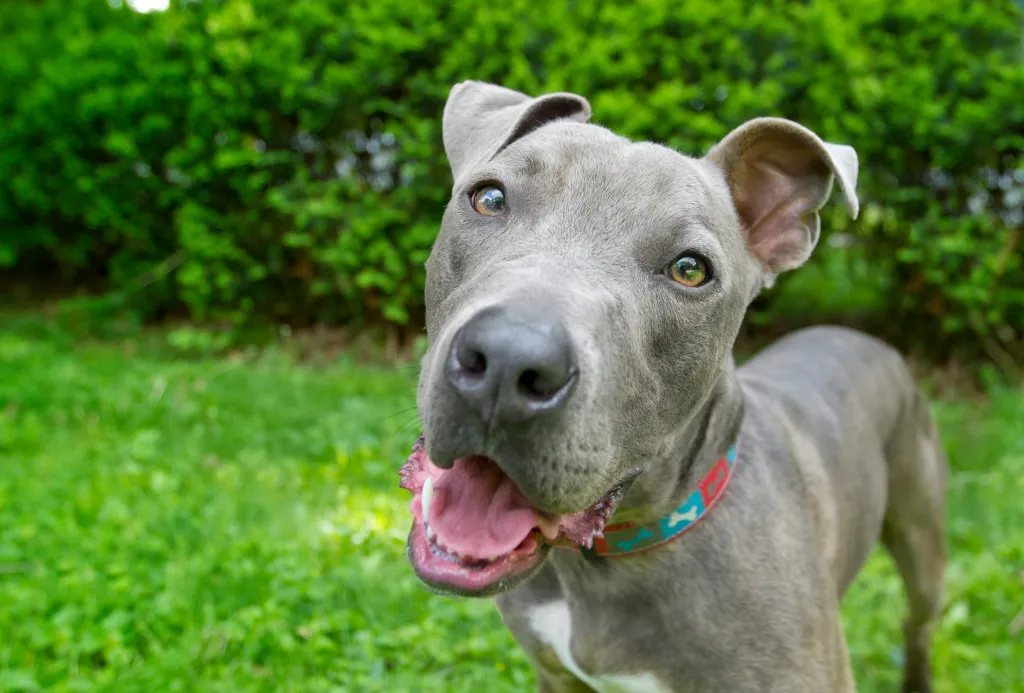
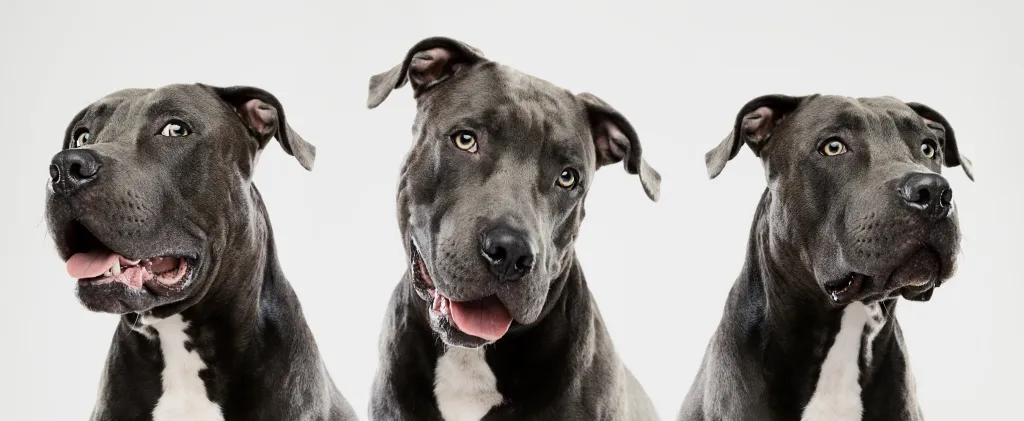

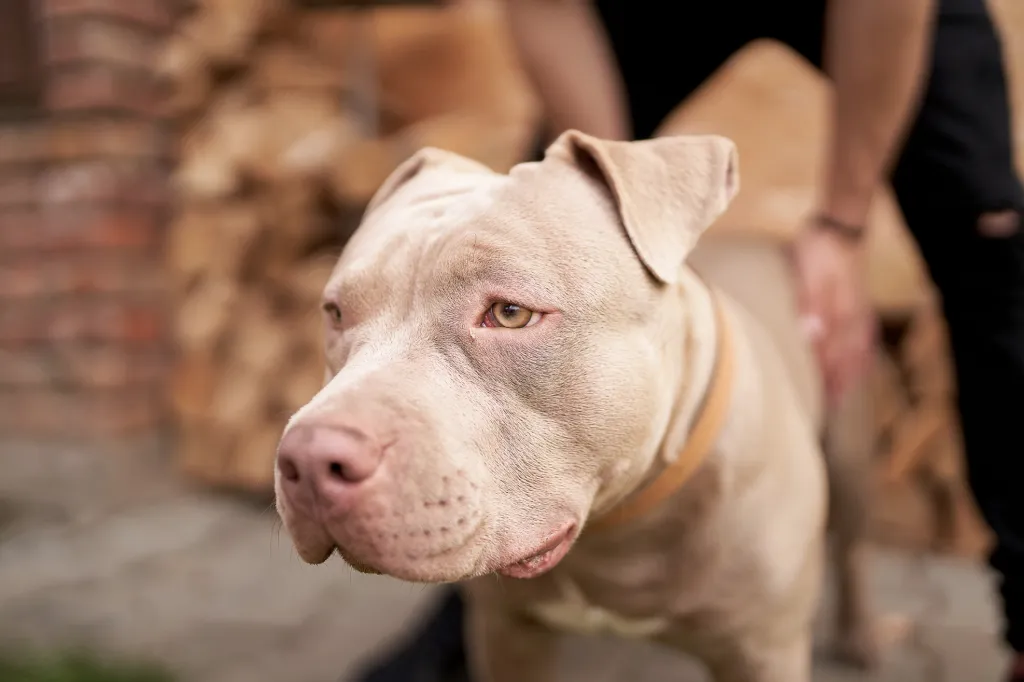
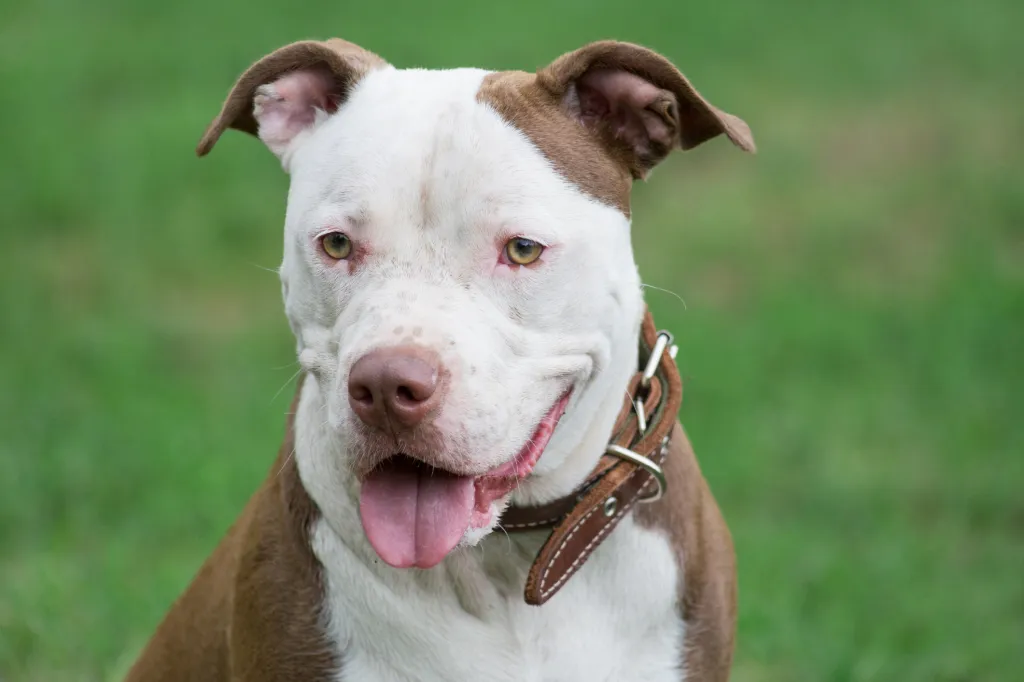

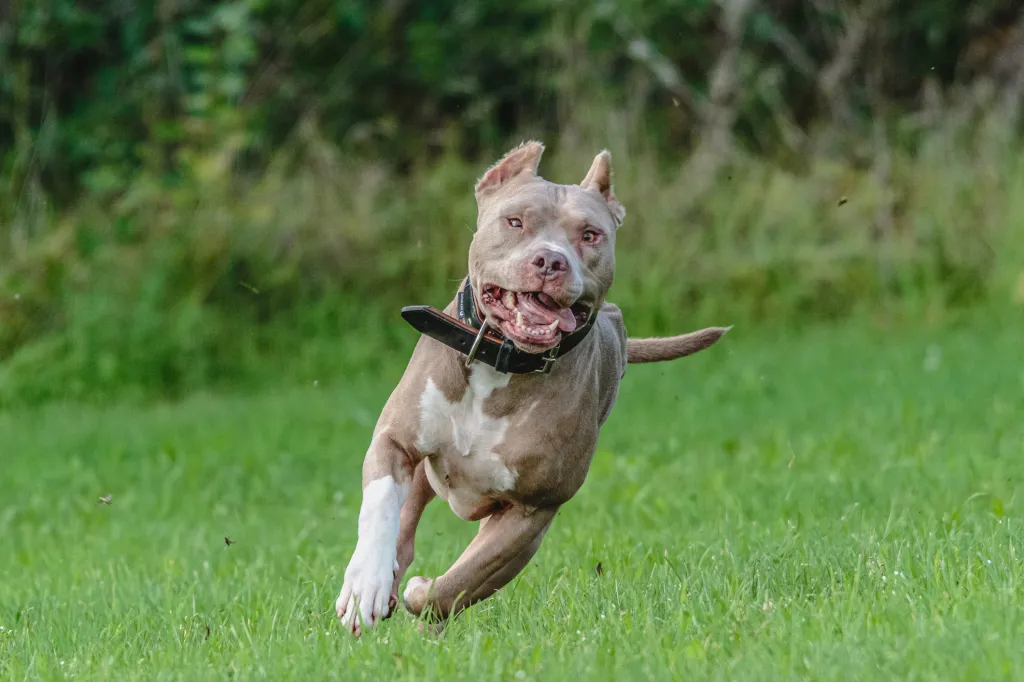
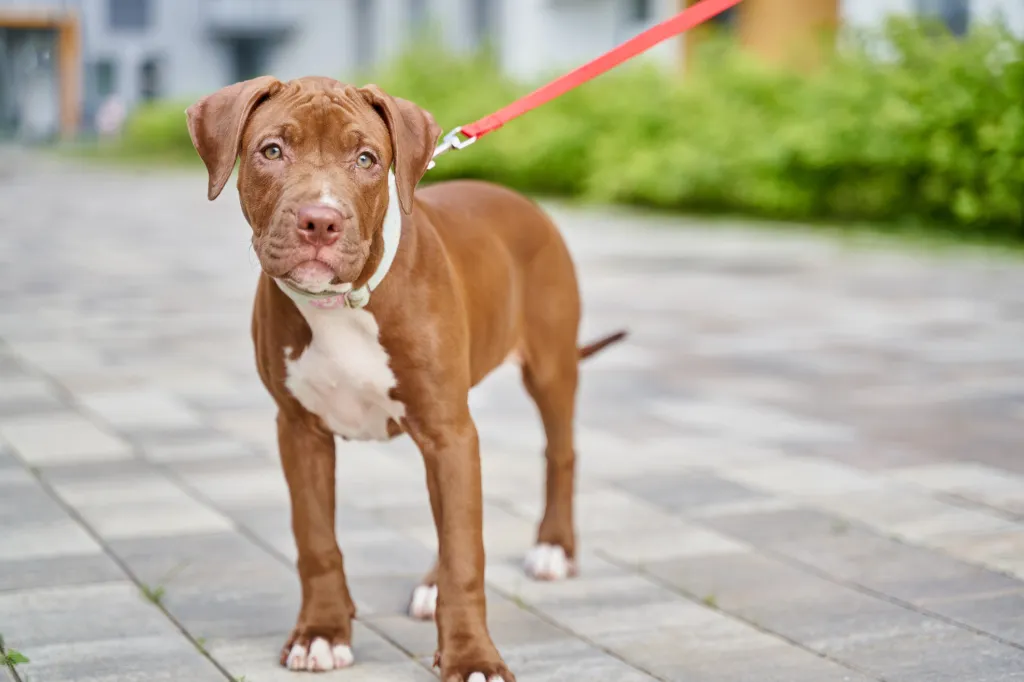
Adaptability
-
Adapts Well To Apartment Living
Looking for the best dog for your apartment? Contrary to popular belief, the suitability of dogs who adapt well to apartment living goes beyond its size. Apartment dwellers have a myriad of dog breeds to choose from as potential companions, with various factors to consider. Some large breeds can adapt well to apartment living and have lower activity levels. Others may require more space and possess higher energy levels. On the other hand, certain small dog breeds with abundant energy can still find contentment with indoor playtime or brisk walks.
However, when selecting a dog that adapts well apartments, it is essential to prioritize your neighbors. Opting for a pet that doesn’t excessively bark and behaves politely when encountering others in shared spaces like is crucial for maintaining a harmonious apartment environment.
In high-rise settings, it’s worth noting that numerous small dogs may exhibit a propensity for high energy and frequent barking. This makes them less suitable for apartment living. Therefore, desirable qualities in an apartment dog encompass being quiet, low-energy, and displaying polite behavior towards other residents.
Factors To Consider When Choosing A Dog For An Apartment
When considering dogs that adapt well to apartments, size alone should not be the sole determinant. Apartment dwellers have a wealth of dog breeds to choose from as potential furry companions. It’s important to remember that the size of your living space is just one factor to consider. While some larger breeds can adapt well to apartment living, with lower, others may require more space and have higher energy levels, making them less suitable for smaller apartments. Conversely, certain small dog breeds with higher energy levels can still thrive in apartments, finding contentment through indoor playtime or brisk walks. However, it is crucial to consider your neighbors’ comfort when selecting a dog. Opt for a pet that doesn’t bark excessively and behaves politely when interacting with others in shared spaces.
Therefore, it’s important to prioritize qualities such as being quiet, low-energy, calm indoors, and exhibiting good manners when living in close proximity to other residents. By considering these factors, you can find a dog that will adapt well to apartment living and create a harmonious living environment for everyone involved.
-
Good For Novice Owners
Some dogs are simply easier than others; they take to training better and are fairly easygoing. They’re also resilient enough to bounce back from your mistakes or inconsistencies.
Dogs who are highly sensitive, independent thinking, or assertive may be harder for a first-time dog parent to manage. You’ll get your best match if you take your dog-owning experience into account as you choose your new pooch.
If you’re new to dog parenting, take a look at 101 Dog Tricks and read up on how to train your dog!
-
Sensitivity Level
Some dogs will let a stern reprimand roll off their backs, while others take even a dirty look to heart. Low-sensitivity dogs, also called “easygoing,” “tolerant,” “resilient,” and even “thick-skinned,” can better handle a noisy, chaotic household, a louder or more assertive owner, and an inconsistent or variable routine. Do you have young kids, throw lots of dinner parties, play in a garage band, or lead a hectic life? Go with a low-sensitivity dog.
-
Tolerates Being Alone
Some breeds bond very closely with their family and are more prone to worry or even panic when left alone by their owner. An anxious dog can be very destructive–barking, whining, chewing, and otherwise causing mayhem. These breeds do best when a family member is home during the day or if you can take the dog to work.
-
Tolerates Cold Weather
Breeds with very short coats and little or no undercoat or body fat, such as Greyhounds, are vulnerable to the cold. Dogs with a low cold tolerance need to live inside in cool climates and should have a jacket or sweater for chilly walks. You can find a great jacket for your dog here!
-
Tolerates Hot Weather
Dogs with thick, double coats are more vulnerable to overheating. So are breeds with short noses, like Bulldogs or Pugs, since they can’t pant as well to cool themselves off. If you want a heat-sensitive breed, your dog will need to stay indoors with you on warm or humid days, and you’ll need to be extra cautious about exercising your dog in the heat.
All-around friendliness
-
Affectionate With Family
When it comes to unconditional love and unwavering loyalty, few animals can rival the affectionate nature of dogs. These remarkable creatures have earned their reputation as man’s best friend, and many breeds are particularly renowned for their love and devotion to their families. With their warm hearts and wagging tails, affectionate family dogs enrich the lives of their owners in countless ways.
One such breed known for its affectionate demeanor is the Golden Retriever. With their gentle temperament and friendly disposition, Golden Retrievers form deep bonds with their families. They eagerly participate in family activities, whether it’s a game of fetch in the yard or cuddling on the couch during a movie night. Their expressive eyes and ever-wagging tails are a testament to the joy they feel in the presence of their loved ones.
Another family-favorite breed is the Labrador Retriever. Renowned for their playful and patient nature, Labradors are excellent companions for children and adults alike. They readily engage in playtime with the kids, showcasing their boundless energy and enthusiasm. But when the day winds down, they seamlessly transition into loving and gentle cuddle buddies, comforting their family members with their warm presence.
Beyond specific breeds, mixed-breed dogs also have a special place in the hearts of families seeking affectionate companions. The shelter dogs, in particular, form deep connections with their adoptive families. They seem to understand the second chance they’ve been given and repay it with endless love and gratitude.
How To Know If A Dog Is Good With Families
The affectionate nature of family dogs extends beyond play and cuddles. Dogs have a remarkable ability to sense their owner’s emotions, offering comfort and support during difficult times. Whether it’s a wagging tail after a long day at work or a sympathetic nuzzle during moments of sadness, they prove time and again that they are attuned to their family’s needs.
It is important to note that not all dogs of the same breed will be equally affectionate. Some dogs may be more independent or aloof, while others may be more clingy or demanding of attention. The best way to find out how affectionate a dog is is to meet them in person and interact with them.
-
Kid-Friendly
Being gentle with children, sturdy enough to handle the heavy-handed pets and hugs they can dish out, and having a blasé attitude toward running, screaming children are all traits that make a kid-friendly dog. You may be surprised by who’s on that list: Fierce-looking Boxers are considered good with children, as are American Staffordshire Terriers (which are considered Pit Bulls). Small, delicate, and potentially snappy dogs such as Chihuahuas aren’t always so family-friendly.
**All dogs are individuals. Our ratings are generalizations, and they’re not a guarantee of how any breed or individual dog will behave. Dogs from any breed can be good with children based on their past experiences, training on how to get along with kids, and personality. No matter what the breed or breed type, all dogs have strong jaws, sharp pointy teeth, and may bite in stressful circumstances. Young children and dogs of any breed should always be supervised by an adult and never left alone together, period.
-
Dog Friendly
Friendliness toward dogs and friendliness toward humans are two completely different things. Some dogs may attack or try to dominate other dogs, even if they’re love-bugs with people; others would rather play than fight; and some will turn tail and run. Breed isn’t the only factor. Dogs who lived with their littermates and mother until at least six to eight weeks of age and who spent lots of time playing with other dogs during puppyhood, are more likely to have good canine social skills.
-
Friendly Toward Strangers
Stranger-friendly dogs will greet guests with wagging tails and nuzzles; others are shy, indifferent, or even aggressive. However, no matter what the breed, a dog who was socialized and exposed to lots of different types, ages, sizes, and shapes of people as a puppy will respond better to strangers as an adult. Remember that even friendly dogs should stay on a good, strong leash like this one in public!
Health And Grooming Needs
-
Amount Of Shedding
If you’re going to share your home with a dog, you’ll need to deal with some level of dog hair on your clothes and in your house. However, shedding does vary greatly among the breeds. Some dogs shed year-round, some “blow” seasonally, some do both, and some shed hardly at all. If you’re a neatnik, you’ll need to either pick a low-shedding breed or relax your standards. To help keep your home a little cleaner, you can find a great de-shedding tool here!
-
Drooling Potential
Drool-prone dogs may drape ropes of slobber on your arm and leave big, wet spots on your clothes when they come over to say hello. If you’ve got a laid-back attitude toward slobber, fine; but if you’re a neatnik, you may want to choose a dog who rates low in the drool department.
-
Easy To Groom
Some breeds are brush-and-go dogs; others require regular bathing, clipping, and other grooming just to stay clean and healthy. Consider whether you have the time and patience for a dog who needs a lot of grooming, or the money to pay someone else to do it.
-
General Health
Due to poor breeding practices, some breeds are prone to certain genetic health problems, such as hip dysplasia. This doesn’t mean that every dog of that breed will develop those diseases; it just means that they’re at an increased risk.
If you’re adopting a puppy, it’s a good idea to find out which genetic illnesses are common to the breed you’re interested in. You may also want to ask if your shelter or rescue has information about the physical health of your potential pup’s parents and other relatives.
-
Potential For Weight Gain
Some breeds have hearty appetites and tend to put on weight easily. As in humans, being overweight can cause health problems in dogs. If you pick a breed that’s prone to packing on pounds, you’ll need to limit treats, make sure they get enough exercise, and measure out their daily food servings into regular meals rather than leaving food out all the time.
Ask your vet about your dog’s diet and what they recommend for feeding your pooch to keep them at a healthy weight. Weight gain can lead to other health issues or worsen problems like arthritis.
-
Size
Get ready to meet the giants of the doggy world! Large dog breeds aren’t just big balls of fluff, they’re like loving, oversized teddy bears on a mission to steal your heart. Need some convincing? Let’s dive into the awesome benefits of owning one!
First things first, these pooches are a living security system! With their impressive size and thunderous barks, they’ll have any would-be intruder running for the hills. Talk about peace of mind! Plus, who needs an alarm when you’ve got a furry giant protecting your castle?
But that’s not all. Large dog breeds are all about loyalty and devotion. They’ll stick by your side through thick and thin, becoming your most dedicated bestie. Their love knows no bounds! When you have a giant fluffball showing you unconditional love, you’ll feel like the luckiest human on the planet.
Now, let’s talk about their talents. These big fellas are the ultimate working partners. With brains and brawn, they’re up for any challenge. From search and rescue missions to lending a helping paw to those in need, these dogs are superheroes in fur coats. They’ll make you proud every step of the way!
Don’t let their size fool you—these gentle giants have hearts as big as their paws. They’re incredible with kids and other pets, spreading their love like confetti. Their patience and kindness make them perfect family pets, ensuring harmony in your household.
Oh, and get ready to break a sweat! These dogs are fitness enthusiasts, and they’ll keep you on your toes. Daily walks, jogs, and play sessions will not only keep them happy and healthy but will also give you a reason to ditch the couch and join in on the fun. It’s a win-win situation!
So, if you’re ready for a dose of big love, go ahead and consider a large dog breed. They’re the best wing-dog you could ever ask for, ready to make your life a thousand times more exciting, loving, and downright awesome! Get ready for the big adventure of a lifetime!
Trainability
-
Easy To Train
Easy-to-train dogs are more adept at forming an association between a prompt (such as the word “sit”), an action (sitting), and a consequence (getting a treat) very quickly. Other dogs need more time, patience, and repetition during training.
Many breeds are intelligent but approach training with a “What’s in it for me?” attitude, in which case you’ll need to use rewards and games to teach them to want to comply with your requests.
Related:
10 Fun, Impressive Tricks You Can Teach Any Dog
-
Intelligence
Dogs who were bred for jobs that require decision making, intelligence, and concentration, such as herding livestock, need to exercise their brains, just as dogs who were bred to run all day need to exercise their bodies. If they don’t get the mental stimulation they need, they’ll make their own work–usually with projects you won’t like, such as digging and chewing. Obedience training and interactive dog toys are good ways to give a dog a brain workout, as are dog sports and careers, such as agility and search and rescue.
-
Potential For Mouthiness
Common in most breeds during puppyhood and in Retriever breeds at all ages, mouthiness means a tendency to nip, chew, and play-bite (a soft, fairly painless bite that doesn’t puncture the skin). Mouthy dogs are more likely to use their mouths to hold or “herd” their human family members, and they need training to learn that it’s fine to gnaw on chew toys, but not on people. Mouthy breeds tend to really enjoy a game of fetch, as well as a good chew on a toy that’s been stuffed with kibble and treats.
-
Prey Drive
Dogs with a high prey drive have an instinctive desire to stalk, capture, and prey upon potential food sources. Dogs who were bred to hunt, such as Terriers, have an inborn desire to chase — and sometimes kill — other animals. Anything whizzing by — such as cats, squirrels, and perhaps even cars — can trigger that instinct.
How to address a high prey drive
Off-leash adventures are too great a temptation for pups who will wander and hunt. Dogs who like to chase need to be leashed. And, even on a leash, you may experience your dog pulling on the leash to reach rodents or birds in their sight. Otherwise, these pups should be kept in a fenced area when outdoors. If your pup has a high prey drive, you’ll need a high, secure fence in your yard.
These breeds generally aren’t a good fit for homes with smaller pets that can look like prey, such as cats, hamsters, or small dogs. Breeds that were originally used for bird hunting, on the other hand, generally won’t chase, but you’ll probably have a hard time getting their attention when there are birds flying by.
Other behavioral concerns
Observing your dog’s prey drive, which is instinctual and biologically-rooted, is not the same as observing aggression. Much aggression is born of fear and anxiety, especially in the case of dog aggression toward humans.
The tendency to wander, even into oncoming traffic, can produce diasterious results for pups with predatory instincts. It can also lead to pups being bitten by snakes or attacked by other wild animals they may pursue while on the hunt.
-
Tendency To Bark Or Howl
Some breeds sound off more often than others. When choosing a breed, think about how often the dog vocalizes. Learn more about breeds with a tendency to bark or howl.
If you’re considering a hound, would you find their trademark howls musical or maddening? If you’re considering a watchdog, will a city full of suspicious “strangers” put your pup on permanent alert? Will the local wildlife literally drive your dog wild? Do you live in housing with noise restrictions? Do you have neighbors nearby? Then you may wish to choose a quieter dog.
-
Wanderlust Potential
Some breeds are more free-spirited than others. Nordic dogs such as Siberian Huskies were bred to range long distances, and given the chance, they’ll take off after anything that catches their interest. And many hounds simply must follow their noses–or that bunny that just ran across the path–even if it means leaving you behind.
Exercise needs
-
Energy Level
High-energy dogs are always ready and waiting for action. Originally bred to perform a canine job of some sort, such as retrieving game for hunters or herding livestock, they have the stamina to put in a full workday. They need a significant amount of exercise and mental stimulation, and they’re more likely to spend time jumping, playing, and investigating any new sights and smells.
Low-energy dogs are the canine equivalent of a couch potato, content to doze the day away. When picking a breed, consider your own activity level and lifestyle, and think about whether you’ll find a frisky, energetic dog invigorating or annoying.
-
Intensity
A vigorous dog may or may not have high energy, but everything they do, they do with vigor: they strain on the leash (until you train them not to), try to plow through obstacles, and even eats and drinks with great big gulps. These dynamos need lots of training to learn good manners, and may not be the best fit for a home with young kids or someone who’s elderly or frail. A low-vigor dog, on the other hand, has a more subdued approach to life.
-
Exercise Needs
Some breeds do fine with a slow evening stroll around the block. Others need daily, vigorous exercise, especially those that were originally bred for physically demanding jobs, like herding or hunting.
Without enough exercise, these breeds may put on weight and vent their pent-up energy in ways you don’t like, such as barking, chewing, and digging. Breeds that need a lot of exercise are good for outdoorsy, active people, or those interested in training their dog to compete in a high-energy dog sport, such as agility.
-
Potential For Playfulness
Some dogs are perpetual puppies — always begging for a game — while others are more serious and sedate. Although a playful pup sounds endearing, consider how many games of fetch or tag you want to play each day, and whether you have kids or other dogs who can stand in as playmates for the dog.
American Pit Bull Terrier Overview
The American Pit Bull Terrier is one of the so-called bully breeds often labeled a pit bull. In fact, “pit bull” isn’t a breed, but a term used to describe the American Pit Bull Terrier, the Bull Terrier, the American Staffordshire Terrier, and the Staffordshire Bull Terrier. Some people say the American Pit Bull Terrier is the same as the American Staffordshire Terrier.
Others, just as forcefully, say they’re entirely different breeds. But all experts can agree that the confusion started with a decision by the AKC in the early 1930s to give it a new name, American Staffordshire Terrier, to separate it from its pit-fighting past. The American Pit Bull Terrier has not been recognized by the AKC, while the American Staffordshire Terrier, which is slightly smaller, has been. The bull breeds are often grossly misunderstood.
The qualities that make these dogs tenacious players in obedience and agility games also attract highly unscrupulous people looking for strong competitors for their dog fighting rings. The sorry result is that bull breeds, in particular the APBT, have gained a reputation over recent years for being dangerous. Nothing could be further from the truth.
But rampant misinformation and fear caused by the actions of a minority of dogs kept by criminally negligent people have provoked legislation against the breed in a number of cities and countries around the world. As the owner of an American Pit Bull Terrier you must be aware that you may be met with anger and hostility by people who are misinformed about your wonderful dog.
This is not a breed for everyone, especially those who aren’t willing to invest time in training and socialization and can’t or won’t provide consistent firm guidance. When raised with the proper training and socialization, the American Pit Bull Terrier makes an excellent companion for children. He is loving and gentle with people and often makes a lousy guard dog because of his tail-wagging eagerness to greet the person at the door. American Pit Bull Terriers are devoted and loyal to their family and will, if necessary, defend them to the death. These dogs are extremely intelligent and learn commands and tricks with ease. They have a zest for life and love to be involved in everything going on around them. They maintain a puppyish demeanor well into adulthood, and that vitality makes them a joy to live with. Once you have met and gotten to know this breed you will wonder how you ever lived without one.
American Pit Bull Terrier Highlights
- American Pit Bull Terriers are not a good choice for people who can give them little or no attention. They must be trained and socialized when young to overcome the breed’s tendencies toward stubbornness and bossiness, which combined with his strength can make him hard to handle if he hasn’t learned you are in charge.
- Your American Pit Bull Terrier must be kept on leash in public to prevent aggression toward other dogs.
- It’s not a good idea to let these dogs run loose in dog parks. While they might not start a fight, they’ll never back down from one, and they fight to the finish. American Pit Bulls who aren’t properly socialized as puppies can become aggressive toward other dogs.
- Breed-specific legislation almost always includes this breed. Be aware of rules in your area as well as neighboring regions if you travel with your dog.
- American Pit Bull Terriers have a great need to chew, and powerful jaws make quick work of cheap or flimsy toys. Give yours only tough, durable toys that can’t be chewed up and swallowed. American Pit Bull Terriers are best suited to owners who can offer firm, fair training, and gentle consistent discipline.
American Pit Bull Terrier History
Bull and terrier breeds were created in early 19th-century England for the popular spectator sports of bull- and bear-baiting. When those sports were deemed inhumane and became illegal 1835, dog-fighting sprung up in its place — and thus was the trait for dog aggression bred into the genetic line.
But another part of this breed’s genetic makeup is an unwillingness to bite humans. Handlers reaching into the dog-fighting rings wanted to be able to separate dogs without getting hurt themselves. Quite soon the breed developed a reputation as a strong, protective dog, but one also known for being gentle and family-friendly. When these “bull dogs” accompanied immigrants to America they began new careers as all-around farm dogs.
Their jobs included hunting wild game, guarding the property from animal intruders, and providing companionship. In keeping with the “bigger is better” mindset of their new country, the settlers developed a dog larger than it had been in England.
In 1898 the UKC, Britain’s equivalent of the AKC, named these bull dogs the American Pit Bull Terrier. The AKC decided to recognize the breed in the early 1930s — but under a new name. Intending to separate it from its pit-fighting past, the AKC named it the American Staffordshire Terrier. Since then the American Staffordshire Terrier has been bred for AKC conformation, or dog shows, while the American Pit Bull Terrier has not been. The results are very slight differences in build and in personality.
American Pit Bull Terrier Size
Height of 18 to 19 inches for males, 17 to 18 inches for females. Weight ranges from 30 to 85 pounds.
American Pit Bull Terrier Personality
These dogs love people and have no idea that their size is something of a deterrent to being a lap dog. Confident and keenly aware of their surroundings, they are watchdogs in that they may alert you to the presence of strangers, but that’s primarily because they’re eager to greet “their” guests.
While their love of people makes them failures as guard dogs, their courage is unmatched and they will defend their family with their lives. Like every dog, American Pit Bull Terriers need early socialization — exposure to many different people, sights, sounds, and experiences — when they’re young. Socialization helps ensure that your your puppy grows up to be a well-rounded dog.
American Pit Bull Terrier Health
American Pit Bull Terriers are generally healthy, but as with all breeds, they’re prone to certain health conditions. Not all American Pit Bulls Terriers will get any or all of these diseases, but it’s important to be aware of them if you’re considering this breed.
- Hip Dysplasia (HD): This condition is a malformation of the hip joint ball and socket. It can be extremely painful depending on the severity of the condition. Dogs who are going to be bred should have x-rays of their hips done at 2 years of age to ensure they do not have this condition.
- Allergies: Allergies are quite common in APBT/AmStaffs. Skin allergies are typically caused by such environmental allergens as fleas, grass, pollen, and dust.They can also be food related, but this is less common. Common food allergens include beef, rice, wheat, and corn. Allergies can cause intense itching and discomfort, which means dogs will dig and chew sometimes till they bleed. This is risky because secondary infections can develop in the damaged tissue. To treat allergies, the cause must be identified and removed from the dog’s environment if possible. A veterinarian can help you with this, as well as let you know which allergy symptoms can be controlled with medication.
- Hypothyroidism: This is a dysfunction of the thyroid gland that causes weight gain, poor coat, reproductive problems and other issues. It usually occurs in middle-aged dogs and can be controlled with daily medication that must continue throughout the dog’s life.
- Heart Disease: Heart disease affects these dogs in several forms, with aortic stenosis being most common. Aortic stenosis is a congenital heart defect, meaning it’s something the dog is born with. It’s an abnormal narrowing of the connection between the left ventricle and the aorta. Some dogs don’t have any signs or only minor signs, while others may have little energy or even die suddenly. If your veterinarian hears a heart murmur, a chest x-ray and electrocardiogram can confirm the diagnosis.
Regardless of how healthy your dog is when you first bring them home, you should prepare for any issues that may come up throughout their life. A pet insurance plan can help you stay ready for any of your dog’s veterinary needs.
American Pit Bull Terrier Care
Expect to spend about an hour a day walking, playing with or otherwise exercising this dog. While they love people, American Pit Bull Terriers are strong for their size and can be stubborn if left to their own devices. Begin obedience training early and continue it throughout the dog’s life. Training is the foundation for a strong relationship with your American Pit Bull Terrier.
American Pit Bull Terriers should not be left outside for long because they can’t tolerate the cold well. Even regardless the climate, these dogs do best as housedogs. They form strong attachments to their families and will suffer if left alone for long periods.
American Pit Bull Terrier Feeding
Recommended daily amount: 1.5 to 2.5 cups of high-quality dry food a day, divided into two meals. NOTE: How much your adult dog eats depends on his size, age, build, metabolism, and activity level. Dogs are individuals, just like people, and they don’t all need the same amount of food. It almost goes without saying that a highly active dog will need more than a couch potato dog. The quality of dog food you buy also makes a difference — the better the dog food, the further it will go toward nourishing your dog and the less of it you’ll need to shake into your dog’s bowl.
To prevent obesity, measure your dog’s food and give meals at set times each day rather than leaving food out all the time. He should have a waist when you look down at him, and you should be able to feel his ribs beneath a layer of muscle but not see them. If the ribs are buried beneath rolls of fat, your dog needs to go on a diet. For more on feeding your American Pit Bull Terrier, see our guidelines for buying the right food, feeding your puppy, and feeding your adult dog.
American Pit Bull Terrier Coat Color And Grooming
The short coat is shiny and stiff to the touch, and comes in all colors — red, blue, brown, grey, black and white, and brindle, among them. They require little grooming, and have a coat that’s easy to keep clean with the occasional bath. Brushing with a stiff brush and wiping down with a cloth will maintain the coat’s shine.
Brush your dog’s teeth at least two or three times a week to remove tartar buildup and the bacteria that lurk inside it. Daily brushing is even better if you want to prevent gum disease and bad breath. Trim his nails once or twice a month if your dog doesn’t wear them down naturally to prevent painful tears and other problems.
If you can hear them clicking on the floor, they’re too long. Dog toenails have blood vessels in them, and if you cut too far you can cause bleeding — and your dog may not cooperate the next time he sees the nail clippers come out. So, if you’re not experienced trimming dog nails, ask a vet or groomer for pointers. His ears should be checked weekly for redness or a bad odor, which can indicate an infection.
When you check your dog’s ears, wipe them out with a cotton ball dampened with gentle, pH-balanced ear cleaner to help prevent infections. Don’t insert anything into the ear canal; just clean the outer ear. Accustom your American Pit Bull Terrier to being brushed and examined when he’s a puppy. Handle his paws frequently — dogs are touchy about their feet — and look inside his mouth and ears. Make grooming a positive experience filled with praise and rewards, and you’ll lay the groundwork for easy veterinary exams and other handling when he’s an adult.
As you groom, check for sores, rashes, or signs of infection such as redness, tenderness, or inflammation on the skin, in the nose, mouth, and eyes, and on the feet. Eyes should be clear, with no redness or discharge. Your careful weekly exam will help you spot potential health problems early.
American Pit Bull Terrier Children And Other Pets
American Pit Bull Terriers love children, and we don’t mean for breakfast. Sturdy, energetic, and tolerant, they are ideal playmates. That said, no dog of any size or breed should ever be left unsupervised with children.
When no adult can be there to oversee what’s going on, dogs should be crated or kenneled, especially after they reach sexual maturity, when they may begin to test the possibility of becoming “pack” leader. Don’t allow children to pull on a dog’s ears or tail.
Teach them never to approach any dog while he’s sleeping or eating or to try to take the dog’s food away. Because of their dog-fighting heritage, some American Pit Bull Terriers retain a tendency to be aggressive with other dogs, but if they are socialized early and trained to know what behavior is expected of them, that aggression can be minimized or overcome, and many are dog- and cat-friendly. Just to be safe, they should always be supervised in the presence of other pets.
American Pit Bull Terrier Rescue Groups
You can find American Pit Bulls, and Pit Bulls, and Pit Bull mixes, in just about every shelter in the country. Several good rescue groups are dedicated to finding homes for these much misunderstood dogs.
All dogs will need veterinary care at some point in their lives. When you adopt, make sure you’re prepared to address any health issues that may come up after you leave the shelter. A pet insurance plan can keep your dog covered.
American Pit Bull Terrier Breed Organizations
Finding a reputable dog breeder is one of the most important decisions you will make when bringing a new dog into your life. Reputable breeders are committed to breeding healthy, well-socialized puppies that will make great companions. They will screen their breeding stock for health problems, socialize their puppies from a young age, and provide you with lifetime support.
On the other hand, backyard breeders are more interested in making a profit than in producing healthy, well-adjusted dogs. They may not screen their breeding stock for health problems, and they may not socialize their puppies properly. As a result, puppies from backyard breeders are more likely to have health problems and behavioral issues.
